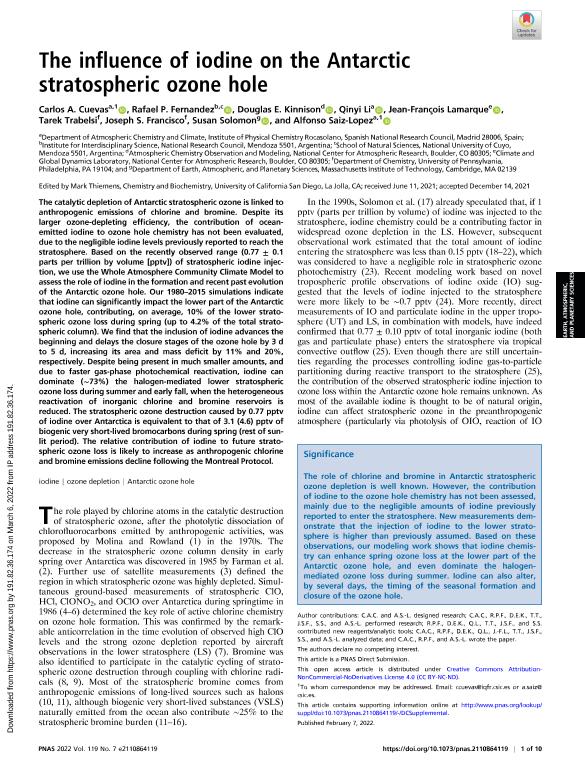Mostrar el registro sencillo del ítem
dc.contributor.author
Cuevas, Carlos Alberto

dc.contributor.author
Fernandez, Rafael Pedro

dc.contributor.author
Kinnison, Douglas E.

dc.contributor.author
Li, Qinyi
dc.contributor.author
Lamarque, Jean François
dc.contributor.author
Trabelsi, Tarek
dc.contributor.author
Francisco, Joseph S.
dc.contributor.author
Solomon, Susan

dc.contributor.author
Saiz López, Alfonso

dc.date.available
2023-08-09T14:00:15Z
dc.date.issued
2022-02
dc.identifier.citation
Cuevas, Carlos Alberto; Fernandez, Rafael Pedro; Kinnison, Douglas E.; Li, Qinyi; Lamarque, Jean François; et al.; The influence of iodine on the Antarctic stratospheric ozone hole; National Academy of Sciences; Proceedings of the National Academy of Sciences of The United States of America; 119; 7; 2-2022; 1-10
dc.identifier.issn
0027-8424
dc.identifier.uri
http://hdl.handle.net/11336/207573
dc.description.abstract
The catalytic depletion of Antarctic stratospheric ozone is linked to anthropogenic emissions of chlorine and bromine. Despite its larger ozone-depleting efficiency, the contribution of oceanemitted iodine to ozone hole chemistry has not been evaluated, due to the negligible iodine levels previously reported to reach the stratosphere. Based on the recently observed range (0.77 ± 0.1 parts per trillion by volume [pptv]) of stratospheric iodine injection, we use the Whole Atmosphere Community Climate Model to assess the role of iodine in the formation and recent past evolution of the Antarctic ozone hole. Our 1980-2015 simulations indicate that iodine can significantly impact the lower part of the Antarctic ozone hole, contributing, on average, 10% of the lower stratospheric ozone loss during spring (up to 4.2% of the total stratospheric column). We find that the inclusion of iodine advances the beginning and delays the closure stages of the ozone hole by 3 d to 5 d, increasing its area and mass deficit by 11% and 20%, respectively. Despite being present in much smaller amounts, and due to faster gas-phase photochemical reactivation, iodine can dominate (∼73%) the halogen-mediated lower stratospheric ozone loss during summer and early fall, when the heterogeneous reactivation of inorganic chlorine and bromine reservoirs is reduced. The stratospheric ozone destruction caused by 0.77 pptv of iodine over Antarctica is equivalent to that of 3.1 (4.6) pptv of biogenic very short-lived bromocarbons during spring (rest of sunlit period). The relative contribution of iodine to future stratospheric ozone loss is likely to increase as anthropogenic chlorine and bromine emissions decline following the Montreal Protocol.
dc.format
application/pdf
dc.language.iso
eng
dc.publisher
National Academy of Sciences

dc.rights
info:eu-repo/semantics/openAccess
dc.rights.uri
https://creativecommons.org/licenses/by-nc-nd/2.5/ar/
dc.subject
ANTARCTIC OZONE HOLE
dc.subject
IODINE
dc.subject
OZONE DEPLETION
dc.subject.classification
Investigación Climatológica

dc.subject.classification
Ciencias de la Tierra y relacionadas con el Medio Ambiente

dc.subject.classification
CIENCIAS NATURALES Y EXACTAS

dc.title
The influence of iodine on the Antarctic stratospheric ozone hole
dc.type
info:eu-repo/semantics/article
dc.type
info:ar-repo/semantics/artículo
dc.type
info:eu-repo/semantics/publishedVersion
dc.date.updated
2023-08-08T13:35:23Z
dc.journal.volume
119
dc.journal.number
7
dc.journal.pagination
1-10
dc.journal.pais
Estados Unidos

dc.journal.ciudad
Washington D.C
dc.description.fil
Fil: Cuevas, Carlos Alberto. Consejo Superior de Investigaciones Científicas. Instituto de Química Física; España
dc.description.fil
Fil: Fernandez, Rafael Pedro. Consejo Nacional de Investigaciones Científicas y Técnicas. Centro Científico Tecnológico Conicet - Mendoza. Instituto Interdisciplinario de Ciencias Básicas. - Universidad Nacional de Cuyo. Instituto Interdisciplinario de Ciencias Básicas; Argentina. Universidad Nacional de Cuyo. Facultad de Ciencias Exactas y Naturales; Argentina
dc.description.fil
Fil: Kinnison, Douglas E.. National Center for Atmospheric Research; Estados Unidos
dc.description.fil
Fil: Li, Qinyi. Consejo Superior de Investigaciones Científicas. Instituto de Química Física; España
dc.description.fil
Fil: Lamarque, Jean François. National Center for Atmospheric Research; Estados Unidos
dc.description.fil
Fil: Trabelsi, Tarek. University of Pennsylvania; Estados Unidos
dc.description.fil
Fil: Francisco, Joseph S.. University of Pennsylvania; Estados Unidos
dc.description.fil
Fil: Solomon, Susan. Massachusetts Institute of Technology; Estados Unidos
dc.description.fil
Fil: Saiz López, Alfonso. Consejo Superior de Investigaciones Científicas. Instituto de Química Física; España
dc.journal.title
Proceedings of the National Academy of Sciences of The United States of America

dc.relation.alternativeid
info:eu-repo/semantics/altIdentifier/url/https://pnas.org/doi/full/10.1073/pnas.2110864119
dc.relation.alternativeid
info:eu-repo/semantics/altIdentifier/doi/http://dx.doi.org/10.1073/pnas.2110864119
Archivos asociados
